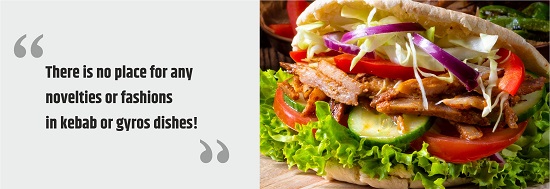Interview with Cezary Linke, Key Account Manager
- Kebab arrived in Poland 20 years ago and at that time it became a cult fast food, standing on the podium next to an American hamburger and an Italian pizza.
- A first kebab bar was opened in Poland in 1998. In these 22 years, we have seen development of thousands of bars and restaurants selling kebabs. Having said so, most of their offer comprises “Polonized” kebabs, adapted to our local tastes, combined with typical Polish additions, such as pickled cucumbers! This kind of dish has little to do with the Turkish original. Especially that kebab did not come to Poland directly from Turkey, but was brought by Turkish immigrants from Berlin – so it already underwent its basic transformation there, adapting the taste profile to European preferences.
- Kebab can be analyzed from numerous points of view. It appears in sociological, political and cultural studies. But what exactly does the customer get at the bar?
- When buying a kebab, the customer receives the healthiest version of fast food! Roasted meat on pita bread with an addition of vegetables and sauce definitely wins comparison to burgers and pizza. The meat is seasoned and specially shaped in the form of a cone; it is roasted on a vertical grill and sliced with a special knife as subsequent layers get roasted. As regards the type of meat, in the original kebab it should be mutton, but in our bars we usually find beef and poultry. Sometimes pork is prepared in a similar way – but then we are talking about gyros coming from Greece. Culture and religion in Turkey and the Middle East forbid consumption of pork in line with the halal rules, so despite the similarity, we cannot call a dish with pork a kebab!
- That is true, many people confuse kebab with gyros. Apart from the type of meat, what else differentiates these two dishes?
- Although these dishes are served in the same way and prepared in a similar way, there are a lot of differences. The basic and the most important one is different types of meat, as I already mentioned. Another difference lies in different origins of these dishes and therefore completely different flavor profiles and different spices. Kebab is a dish from the Middle East, so it is dominated by oriental spices – Roman cumin, coriander, cloves, cinnamon, pepper. Gyros, on the other hand, is seasoned with spices associated with traditional Greek cuisine: garlic, pepper, oregano, rosemary, and thyme.
These traditional flavors and traditional spices are the basics. There is no place for any novelties or fashions in these dishes. They may vary in how spicy they are or some spices may be more noticeable, however the basic flavor profile does not change.

- What does the production of meat for kebab and gyros look like at an earlier stage – i.e. before it gets on the grill in a bar?
- Pieces of meat are seasoned with a mixture of spices, however each producer has its own individual flavors. The rule here is that the meat should be very aromatic and intense in flavor. 2 to 3 times more spices are used in kebabs than in other meat products! The meat is then shaped on a skewer and deep-frozen. Owing to the freezing, the meat does not need to be treated with any preservatives and the amount of E additives can be significantly reduced. An adhesive that helps keeping the meat in the form of a cone is the only functional agent permitted as an additive to kebabs. Once the meat is placed on the grill, it should be completely sliced within one working day!
- Thank you for the interview!
udostępnij udostępnij




